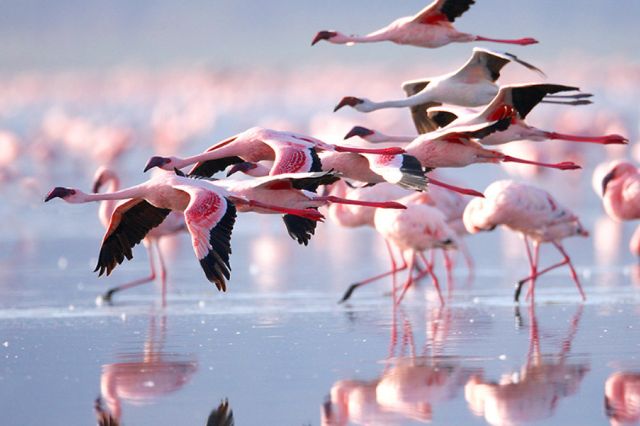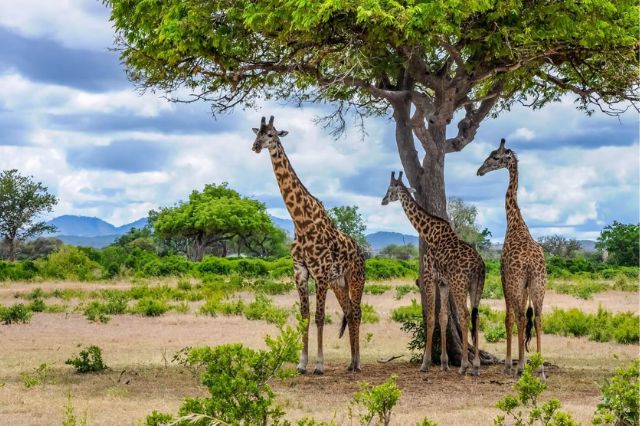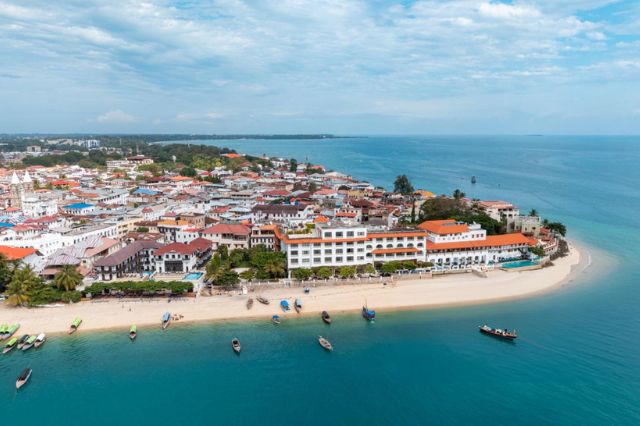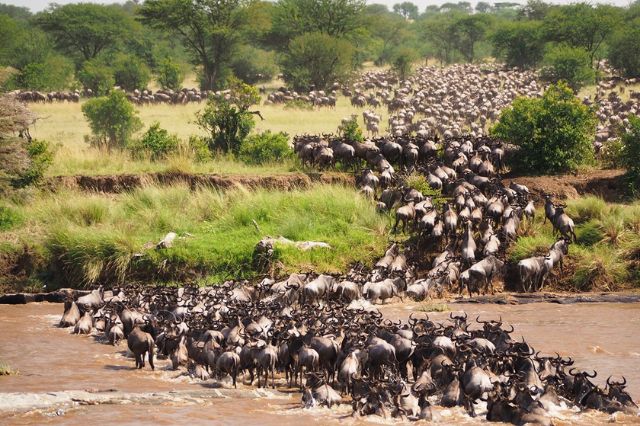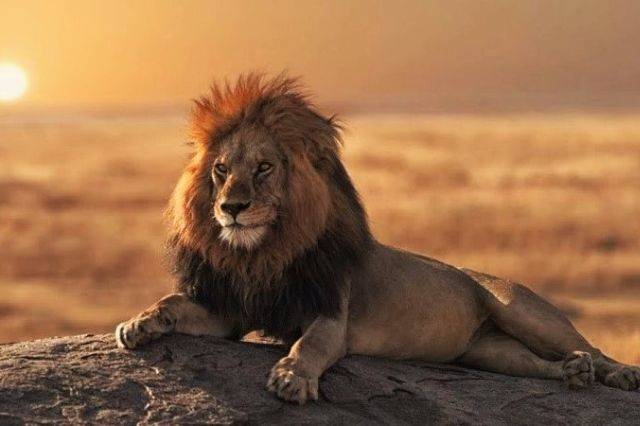Arusha National Park
What to Expect at Arusha National Park
Visitors can also enjoy unique activities such as guided walking safaris to get a closer look at the flora and fauna, as well as cultural experiences with nearby Maasai communities, which offer insights into local traditions and lifestyles. Whether you come during the dry season for excellent game viewing or the wet season for vibrant birdlife and lush scenery, Arusha National Park promises a memorable and diverse adventure.
Arusha National Park is a year-round destination, but the best time to visit largely depends on what you want to experience:
Dry Season (June to October)
This is the peak time for wildlife viewing. The park’s vegetation thins out, and animals congregate around water sources, making it easier to spot them. Giraffe herds are particularly abundant, and the dry season offers clear skies and pleasant temperatures. This period is ideal for game drives and observing large numbers of animals, including buffaloes and various antelope species.
Wet Season (November to May)
The wet season brings lush greenery and a rejuvenated landscape. While some areas may become muddy and game viewing can be more challenging, this is a great time for birdwatching as migratory species arrive, and the park is less crowded. The rain also enhances the scenery with vibrant colors, making it a good time for photographers and those who enjoy a more tranquil safari experience.
Both seasons offer unique advantages, so your choice depends on your preferences for wildlife sightings and landscape aesthetics.
Arusha National Park stands out as a premier safari destination due to its unique combination of wildlife, landscapes, and experiences. The park is renowned for its diverse wildlife, including herds of giraffes, buffaloes, and the elusive leopard, which can often be spotted in the lush forests and open savannahs. This rich ecosystem provides spectacular game viewing opportunities throughout the year, making it a must-visit location for safari enthusiasts.
Beyond its remarkable wildlife, Arusha National Park offers a quieter and more intimate safari experience compared to other major parks. With fewer crowds, visitors can enjoy a more serene environment and personalized attention from guides. The park also provides unique activities such as guided walking safaris and cultural interactions with local Maasai communities, offering insights into traditional lifestyles and enriching your overall safari adventure. The breathtaking landscapes, including volcanic formations, stunning views of Mount Meru, and vibrant lakes, create a stunning backdrop for wildlife encounters, making your visit truly unforgettable.
Mountain Biking: For a more active experience, consider renting a mountain bike to explore designated trails. This allows you to cover more ground and experience the park’s beauty at your own pace.
Wildlife Spotting at Fig Tree Forest: Walk through the lush Fig Tree Forest, where you might encounter various wildlife, including monkeys and unique bird species. The dense canopy provides a cool and shaded environment.
Horseback Safaris: Experience the park from a different perspective by taking a horseback safari. This unique way to explore allows you to get closer to wildlife in a more intimate setting.
Photography Workshops: Join a photography workshop to enhance your skills while capturing the stunning landscapes and wildlife of Arusha National Park. Local guides can offer tips on the best spots and techniques.
Visit the Cultural Heritage Centre: Just outside the park, the Cultural Heritage Centre showcases Tanzanian art, crafts, and culture. It’s a great way to learn more about the country’s diverse heritage.
Sunset Views at Mount Meru: If you’re up for a challenge, consider hiking to one of the viewpoints on Mount Meru to catch a breathtaking sunset. The views of the surrounding plains and distant Kilimanjaro are truly unforgettable.
Mount Meru Hotel
Arusha Coffee Lodge
Kigongoni Lodge
Ngurdoto Mountain Lodge
Ready to Begin Your Tanzanian Adventure?
Exclusive Arusha National Park Adventure Itinerary Request
Popular questions about African safari tours
Can I take children on the African safari?
African safaris are increasingly popular among families, accounting for over 45% of visitors. While some lodges set an age limit of 5, children aged four and up often find the experience enthralling. While kids can marvel at natural wonders like the Ngorongoro Crater or Victoria Falls, it’s the diverse wildlife that truly captivates and excites them the most. We recommend preparing children beforehand to make the trip even more interesting for them. African-themed books, games, or activities are fantastic for that. Going on a Tanzanian safari with children is an exciting and safe experience for the whole family. Still, parents should remain vigilant when venturing into the wild expanses of this beautiful country and not let kids wander off.
When is the best time to go for an African safari in Tanzania?
The ideal time for a Tanzanian safari depends on personal preferences. Opting for a rainy season safari, from November to late December and from mid-March to May, can be cost-effective due to seasonal hotel discounts. There are also much fewer other travelers in the parks. However, be prepared for potential all-day rains.
The other months, spanning from January to mid-March and June to October, generally promise excellent, sunny weather, though there can be exceptions. These dry season periods attract the most tourists. The festive season around Christmas is often the easiest. Safari prices are higher during these times.
We believe the optimal time for a safari is at the cusp of these peak season times. In late October, early March, and early June. These transitional periods offer a sweet spot where the rains are either yet to start or just ending, and the tourist influx is still minimal, providing a balanced experience of good weather and relative tranquillity.
Where to go for an African safari?
Tanzania stands out as the best safari destination in Africa. In 2023, the country won the prestigious World’s Leading Safari Destination title. Its stunningly beautiful national parks and developed infrastructure make Tanzania the ideal choice for memorable and safe African safari tours.
Another famous destination in East Africa is Kenya, famous for its Maasai Mara National Reserve and Amboseli National Park. Botswana with its Chobe National Park, South Africa with numerous wildlife reserves near Cape Town and Kruger National Park, and picturesque Namibia represent famous destinations in southern Africa.
Zambia and Zimbabwe boast the majestic Victoria Falls. The latter is famous for Matobo National Park and Hwange National Park. Uganda and Rwanda captivate with their renowned adventures in East-Central Africa that include observing mountain gorillas and other wild animals.
Can I combine a Kilimanjaro climb with a wildlife safari?
Combining a Kilimanjaro climb with a wildlife safari is seamless and convenient. Landing at Kilimanjaro International Airport places you just 50 km away from the base of Mount Kilimanjaro. Additionally, the popular northern safari parks are within a comfortable driving distance from the airport. For those with limited time, there are shorter 2-3 day safari options that offer a captivating glimpse into Tanzania’s magnificent wildlife. Plus, bush flights are available for even swifter transitions.
Where are the best beach vacation destinations in East Africa?
East Africa boasts exquisite beach destinations, such as Quirimbas in Mozambique, Kenya’s Diani and Lamu, and Anse Source D’Argent in the Seychelles. Zanzibar in Tanzania remains a sought-after spot. For a quieter retreat, Tanzania’s Mnemba, Mafia, and Pemba islands offer unparalleled diving amidst untouched coral reefs.

